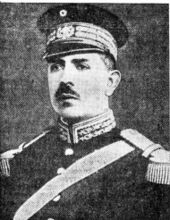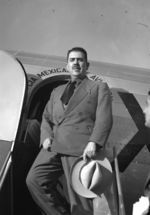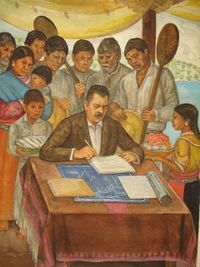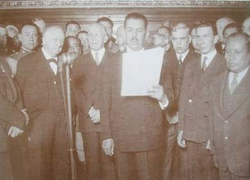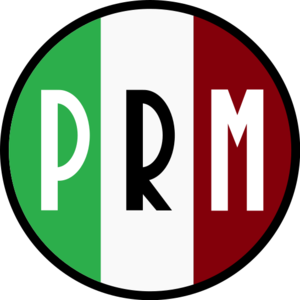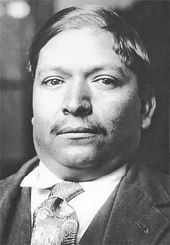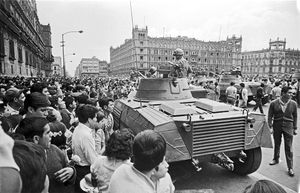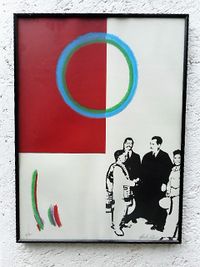لازارو كاردناس
- هذه المقالة هي عن الجنرال لازارو كاردناس دل ريو. لقراء المقالة عن حفيده، انظر لازارو كاردناس باتل. للميناء البحري، انظر لازارو كاردناس، ميچواكان
| لازارو كاردناس Lázaro Cárdenas | |
|---|---|
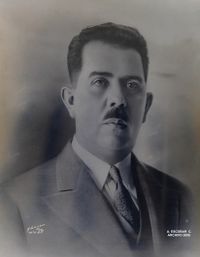
| |
رئيس المكسيك رقم 51 | |
| في المنصب 1 ديسمبر، 1934 – 30 نوفمبر، 1940 | |
| سبقه | أبلاردو رودريگز |
| خلفه | مانويل أڤيلا كماتشو |
| Secretary of National Defence | |
| في المنصب 1 September 1942 – 31 August 1945 | |
| الرئيس | Manuel Ávila Camacho |
| سبقه | Jesús Agustín Castro |
| خلفه | Francisco Luis Urquizo |
| حاكم ميچواكان | |
| في المنصب 1928–1932 | |
| سبقه | لويز منديز |
| خلفه | دماسو كاردناس |
| President of the Institutional Revolutionary Party | |
| في المنصب 16 October 1930 – 27 August 1931 | |
| سبقه | Emilio Portes Gil |
| خلفه | Manuel Pérez Treviño |
| تفاصيل شخصية | |
| وُلِد | 21 مايو 1895 خيكيلپان، ميچواكان |
| توفي | 19 أكتوبر 1970 مكسيكو سيتي |
| القومية | مكسيكي |
| الحزب | حزب الثورة المكسيكية |
| الزوج | أماليا سلورزانو |
| الأنجال | كواوتيموك كاردناس |
| المهنة | رجل دولة، جنرال |
| الخدمة العسكرية | |
| الولاء | |
| الخدمة/الفرع | الجيش المكسيكي |
| الرتبة | جنرال |
| قاد | الثورة المكسيكية |
لازارو كاردناس دل ريو Lázaro Cárdenas del Río (عاش 21 مايو 1895-19 أكتوبر 1970) سياسي مكسيكي كان رئيسًا للمكسيك من عام 1934 إلى عام 1940. وقد حقق أهداف ثورة عام 1910 المكسيكية الإصلاحية إلى مدى أبعد من أي رئيس آخر. ومن أهم إنجازاته البرنامج الذي منح الأرض للفقراء، وإنشاء المدارس. وقد ثار جدل حول تأييده لإضراب عمال النفط الذي أدى إلى مصادرة ممتلكات النفط الأجنبية عام 1938. كما ثار الجدل أيضًا حول فرض سيطرة الدولة على المشاريع الزراعية الكبرى، وهي مزارع القطن، والسكر والسيزال والأرز.
Born in Jiquilpan, Michoacán, to a working-class family, Cárdenas joined the Mexican Revolution and became a general in the Constitutionalist Army. Although he was not from the state of Sonora, whose revolutionary generals dominated Mexican politics in the 1920s, Cárdenas was hand-picked by Plutarco Elías Calles, Sonoran general and former president of Mexico, as a presidential candidate and won in the 1934 general election.
After founding the National Revolutionary Party (PNR) in the wake of the assassination of president-elect Álvaro Obregón, Plutarco Elías Calles had unofficially remained in power during the Maximato (1928–1934) and expected to maintain that role when Cárdenas took office.[1] Cárdenas, however, out-maneuvered him politically and forced Calles into exile. He established the structure of the National Revolutionary Party, eventually renamed the Party of the Mexican Revolution (PRM), on the sectoral representation of peasant leagues, labor union confederations, and the Mexican Army. Cárdenas's incorporation of the army into the party structure was a deliberate move to diminish the power of the military and prevent their intervention in politics through coups d'état.
A left-wing economic nationalist, Cárdenas led the expropriation of the Mexican oil industry and the creation of the state-owned oil company Pemex in 1938.[2] He implemented large-scale land reform programs in Mexico, redistributing large estates to smallholders in lands termed ejidos. He created the National Polytechnic Institute (IPN) and El Colegio de México (Colmex). His foreign policy supported and gave asylum to Republicans during the Spanish Civil War. An achievement of Cárdenas was his complete surrender of power in December 1940 to his successor, Manuel Ávila Camacho, who was a political moderate without a distinguished military record.
Cárdenas has been praised as "the greatest constructive radical of the Mexican Revolution", for implementing its ideals, but has also been criticized as an "authoritarian populist".[3] He was the first Mexican president to serve for a sexenio, a practice that continues today. According to numerous opinion polls and analysts, Cárdenas is the most popular Mexican president of the 20th century.[4][5][6]
حياته
وُلِدَ كاردناس يوم 21 مايو 1895 في خيكيلپان، ميچواكان. في سنة السادسة عشر كان يعول عائلته (والدته وسبعة أشقاء صغار) بعد وفاة والده. في الثامنة عشر عمل جامع ضرائب، طباع، وسجان. بالرغم من أنه ترك المدرسة في سنة الحادية عشر، الا أنه كان يستغل أي فرصة ليعلم نفسه، وكان قارئ جيد طواله حياته خاصة للأعمال التاريخية. كان يطمح كاردناس أن يصبح معلماً، لكنه اندمج في العمل السياسي والعسكري أثناء الثورة المكسيكية بعد أن اطاح ڤكتوريانو هوِرتا بالرئيس فرانشيسكو ماديرو. وانضم للجيش الثوري عام 1913، وأدى دورًا نشطًا في كثير من أعماله العسكرية والسياسية. دعم كاردناس پلوتاركو إلياس كالس بعد أن تولى كالس الرئاسة، وأصبح كاردناس حاكم ميچواكان عام 1928.
أثناء فترة حكمه لميچواكان التي امتدت لأربع سنوات، بدأ في اعادة توزيع الأراضي على مستوى الولاية، وشجع تنظيمات المزراعين والعمال، وقام بتطوير التعليم في الوقت الذي كان مهملاً من الحكومة الاتحادية. وكان كاردناس يعمل على دفع رواتب المدرسي في موعدها، ويقوم بالتفتشي على الكثير من الفصول الدراسية، وافتتح مئات المدارس الجديدة في الريف. وكانت الأصول التي نشأ عليها في الحكم هي نفسها التي اتبعها أثناء حكمه لميچواكان، اتخذ كاردناس قرارات سياسية هامة معتمداً على المعلومات المباشرة التي يتلقاها من الجمهور أكثر من النصائح التي يسديها له مستشاريه.[7]
رئاسة المكسيك
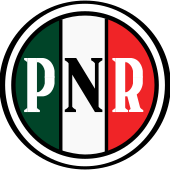
واصل كالس السيدرة على المكسيك بعد توليه الرئاسة وكانت الوزارات كالدمى تحت تصرفه. بعد اختياره لاثنين من المقربين له وتعينهم في المنصب، تراجع الحزب الثوري المؤسسي عن اختياره الاول، مانول پـِرس تريڤينو، عام 1932. بدلا من أن يختار الحزب كاردناس ليكون مرشحاً للحزب في الانتخابات الرئاسية، ترشح كالدس لخوض الانتخابات، معتقداً أنه سيتمكن من الفوز بها مثلما حدث في الانتخابات السابقة. ولكن حدث أن فاز كاردناس بالمنصب في عام 1934 واقتطع نصف راتبه الرئاسي. بعد توليه الرئاسة، انقلب كاردناس والكونگرس المكسيكي على كالس condemned his continued war-like persecution of the Catholic Church.[8] عام 1936، أمر كاردناس باعتقال كالس و11 من المقربين له وتم ترحيلهم للولايات المتحدة، [9] وحظى هذا القرار بترحاب شعبي من غالبية المكسيكيين.
خطة السنوات الست والحملة الرئاسية
أثناء رئاسته، اشتهر كاردناس ببرنامجه التقدمي لبناء الطرق والمدارس وتشجيع التعليم، بتمويل يقدر بضعف الأموال التي خصصها سابقوه للتعليم في المناطق الريفية.[7] وشجع أيضاً استصلاح الأراضي والتأمين الاجتماعي.
أثناء حكمه، أعلن اتباعه لخطة السبع سنوات التي تبناها الحزب الثوري الوطني، للاصلاح الاجتماعي والسياسي.[9] دعت الخطة إلى: 1- استعادة نظام إخيدوس (الأراضي المشتركة) من خلال برنامج صارم لمناهضة هيمنة المزراع الكبيرة.
2- مدارس علمانية معاصرة تدرس المذاهب العقلانية وتكافح "تعصب" الكنيسة.
3- تأسيس النقابات العمالية لمقاومة تجازوات الرأسمالية الصناعية.[9]
في وقت لاحق، أصدر كاردناس مرسوماً بإنهاء تطبيق عقوبة الإعدام (في المكسيك، كانت تطبق عادة باطلاق النار). ومنذ ذلك الوقت منعت عقوبة الإعدام في المكسيك. إن سيطرة الشعب بواسطة كاردناس والحزب الثوري المؤسساتي وسلفه الحزب الثوري الوطني دون اراقة الدماء، كانت نهاية للتمردات التي بدأت بالثورة المكسيكية 1910. على الرغم من سياسة التعليم الاشتراكي القسري التي فرضها كاردناس، فقد تحصسنت العلاقات مع الكنيسة بشكل كبير أثناء حكمه.[10]
أسلوبه الرئاسي
قد يكون كاردناس هو الرئسي المكسيكي الوحيد الذي لم يستخدم عربات مدرعة أو حراس شخصيون لحمايته. في الحملة الانتخابية الرئاسية 1934، سافر كاردناس لكثير من مدن المكسيك التي لم يكن بها خدمة القطارات، ووصلها بالسيارة أو بواسطة الخيول، برفقة سائق أو معاون شخصي. خلقت هذا الجسارة احترام واسع النطاق لكاردناس لدى جمهور الناخبين. كان كاردناس أول من أقام في المقر الرئاسي الرسمي الحالي في لوس پينوس، وتم تحويل المقر السابق القصر اللملكي قلعة چاپولتپك، للمتحف الوطني للتاريخ.
كان المنفي الروسي ليون تروتسكي مرحباً به في المكسيك من قبل كاردناس، وكان ذلك رداً على اتهام كاردناس بأنه ستاليني. تفهم كاردناس، مثل سلفه في العشرينيات ألڤارو اوبرگون، أن دعمه لليسار واتحاد العمال حاسماً لسيطرته على الجمهورية. تم تهميش الاتحاد الاقليمي للعمال المكسيكيين الفاسد، برئاسة لويس مورنس، حيث كان كاردناس يشجع اتحاد العمال المكسيكيين بزعامة الاشتراكي ڤيسنت لومباردو تولدانو.
سياساته في المنصب
الاصلاح الزراعي
During Cárdenas' presidency, the government enacted land reform that was "sweeping, rapid, and, in some respects, innovative.[11] He redistributed large commercial haciendas, some 45 million acre (180،000 km2) of land to peasants.[12] With the powers of Article 27 of the Mexican constitution, he created agrarian collectives, or ejidos, which in early twentieth-century Mexico were an uncommon form of landholding.[13] Two high profile regions of expropriation for Cárdenas's agrarian reform were in the productive cotton-growing region in northern Mexico, known as La Laguna, the other was in Yucatan, where the economy was dominated by henequen production.[14] Other areas that saw significant land reform were Baja California and Sonora in northern Mexico and his home state of Michoacan and Chiapas in southern Mexico.[13]
الاصلاح العمالي
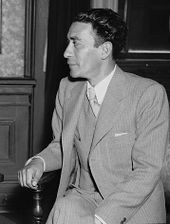
القطاع الرئيسي الآخر للإصلاح كان عمال المصانع. المادة 123 من دستور 1917 منحت العمال سلطات بشكل غير مسبوق، فضمنت حقوقاً للعمال مثل يوم الثمان ساعات وحق الاضراب، ولكن بشكل أكثر شمولاً، فإن المادة 123 أعطت الاشارة بأن الدولة المكسيكية هي في صف العمال. A labor organization already existed when Cárdenas took office, the CROM union of لويس مورونـِس. Morones was forced out of his cabinet post in Calles's government and the CROM declined in power and influence, with major defections of Mexico City unions, one of which was led by socialist ڤيسنتى لومباردو تولدانو. Cárdenas promoted Toledano's "purified" Confederation of Mexican Workers, which evolved into the Mexican Confederation of Workers or CTM. The CTM's alliance with Cárdenas was tactical and conditional, seeing their interests being forwarded by Cárdenas, but not controlled by him.[15] As with the agrarian sector with mobilized peasants, mobilized and organized workers had long agitated and fought for their interests. المادة 123 من الدستور كانت نتيجة ملموسة لمشاركتهم في الثورة المكسيكية في جانب الدستوريين. في الواقع، فإن العمال الذين نظـّمهم كازا دل أوبريرو مونديال، المنظمة العمالية الراديكالية، قاتلوا في الكتائب الحمراء ضد الثوريين الفلاحين بقيادة إميليانو زاپاتا. وقد ساند لومباردو تولدانو والـ CTM قيام كاردناس بنفي كالـِس وفي نفس الضربة قام كاردناس بنفي زعيم CROM الفاقد للمصداقية، لويس ناپليون مورونـِس.[16]
أمّم كاردناس نظام السكك الحديدية خالقاً السكك الحديدية الوطنية المكسيكية في 1938 ووضعها تحت "ادارة العمال." إلا أن أهم خطط التأميم التي قام بها كان تأميم صناعة النفط في 1938.
تأميم النفط
ارتفعت مكانة المكسيك العالمية خلال الحرب العالمية الثانية إثر مساندة كاردناس وتدعيمه للتعاون الداخلي بين دول أمريكا.
كما كان مركزياً في مشروع كاردناس السياسات الاقتصادية الوطنية التي تتضمن ثروات المكسيك الهائلة من النفط، التي ارتفعت بعد اكتشافات 1910 في المنطقة التي تعرف حالياً باسم "طريق الذهب"، بالقرب من تامپيكو، التي جعلت من المكسي ثاني أكبر منتج للنفط في العالم عام 1921، حيث تغطي 20% تقريباً من الطلب المحلي في الولايات المتحدة.
عمل كاردناس على عقد مناقشات مع النسر المكسيك، بمراقبة ادارية من رويال دتش/شل وستاندرد أويل أوف نيوجرزي، ولم تسفر المناقشات عن أي تقدم، ورفضت الشركات الحل المقترح من اللجنة الرئاسية. في الساعة 9:45 م مساء 18 مارس 1938، أعلن كاردناس تأميم احتياطيات النفط المكسيكي ومرافق شركات النفط الأجنبية في المكسيك. وفي أعقاب الاعلان خرج موكب لمدة ست ساعات في مكسيكو سيتي، وجاء ذلك في أعقاب حملة لجمع تبرعات لمساعدة الشركات الوطنية.
على الرغم من أن مرسوم التأميم تضمن تعويضات عن الأصول المؤممة، فقد أثار هذا القرار غضب جمعية الأعمال الدولية والحكومات الغربية، خاصة المملكة المتحدة. كانت الحكومة أكثر تخوفاً على فقدان المعرفة الفنية المطلوبة لتشغيل مصافي النفط. قبل مغادرتهم، حرصت شركات النفط ألا تترك خلفها أي شيء ذو قيمة للحكومة المكسيكية، متأملة أن يجبر ذلك كاردناس على قبول شروطهم. بالرغم من أن المكسيك سرعان ما كانت قادرة على اعادة تشغيل حقول ومصافي النفط ، فإن الانتاج لم يصل للمستويات السابقة إلا أن دخلت الولايات المتحدة الحرب العالمية الثانية، حيث أرسلت الولايات المتحدة مستشارين فنيين كجزء من جهود الحلفاء.
انقطعت العلاقات الدبلوماسية البريطانية مع حكومة كاردناس، وكانت هناك مقاطعة للنفط المكسيكي وكذلك للسلع والمنتجات الأخرى، بالرغم من أن الحكم الدولي كان لصالح حكومة المكسيك. ومع اندلاع الحرب العالمية الثانية، لاقى النفط رواجاً كبيراً. بدأ المكسيك في تصدير النفط لألمانيا النازية وإيطاليا الفاشية.[17]
الشركة التي أسسها كاردناس، الشركة المكسيكية للنفط (أو پمكس)، أصبحت فيما بعد نموذج للبلدان التي تسعى لسيادة أكبر على مواردها من النفط والغاز الطبيعي، وبعد 70 سنة، لا زالت تعتبر من أكبر الموارد الرئيسية للدخل في البلاد، على الرغم من ضعف الموارد المالية بها. وللاحتياج لضمان تواجد الخبرة الفنية، أسس كاردناس معهد الپوليتكنيك الوطني.
السكان الأصليون
Cárdenas created the new cabinet-level Department of Indigenous Affairs (Departamento de Asuntos Indígenas) in 1936, with Graciano Sánchez, an agrarista leader in charge. After a controversy at the DAI, Sánchez was replaced by a scholar, Prof. Luis Chávez Orozco.[18] Cárdenas was influenced by an advocate of indigenismo, Moisés Sáenz, who earned a doctorate in education from Columbia University and had held a position in the Calles administration in the Secretariat of Public Education (SEP). Although initially an assimilationist for Mexico's indigenous, he shifted his perspective after a period of residence in a Purépecha village, which he published as Carapan: Bosquejo de una experiencia. He came to see indigenous culture as having value.[19] Sáenz advocated for educational and economic reforms that would better the indigenous, and this became the aim of the department Cárdenas created.
حق المرأة في الانتخاب
حزب الثورة المكسيكية (PRM)
الحرب الأهلية الاسبانية واللاجئون الجمهوريون إلى المكسيك
ثورة ساتورنينو سديو الفاشلة، 1938-1939
الانتخابات الرئاسية 1940
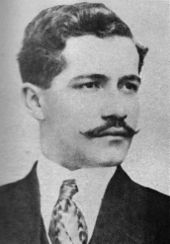
In the elections of 1940, Cárdenas, hoped to prevent another uprising or even "an outright counter-revolution throughout the Republic" by those opposed to his leftist policies,[20] endorsed the PRM nominee Manuel Ávila Camacho, a moderate conservative.[21][22] Obregonista Francisco Múgica would have been Cárdenas's ideological heir, and he had played an important role in the Revolution, the leader of the left wing faction that successfully place key language in the Constitution of 1917, guaranteeing the rights of labor.[23] Múgica had known Cárdenas personally since 1926 when the two were working in Veracruz. Múgica had served in Cárdenas's cabinetas Secretary of the National Economy and as Secretary of the Ministry of Communications and Public Works. In those positions, Múgica made sure the federal government pursued social goals; Múgica was considered "the social conscience of Cardenismo."[24] Múgica resigned his cabinet post to be a candidate for the 1940 presidential election.[25]
Much to the surprise of Mexicans who expected that Cárdenas might follow the example of Calles and remain the power behind the presidency—particularly since Ávila Camacho did not appear to have major leadership skills at a time that the conflict in Europe and domestic turmoil were in evidence—he set the important precedent of leaving the presidency and its powers to his successor.[26]
ما بعد الرئاسة

بعد انتهاء فترته الرئاسية في 1 ديسمبر 1940، عمل كاردناس وزيراً للحربية 1942-1945، when Mexico was a solid participant in World War II, which reassured Mexican nationalists concerned about a close alliance with the United States.[27][28]
ويقال عادة أن كاردناس كان الرئيس الوحيد المنتمي إلى الحزب الثوري المؤسساتي، الذي لم يستغل منصبه لتحقيل ثروات شخصية. تقاعد كاردناس في منزله المتواضع على بحيرة پاتزكوارو، ميتشواكان، وعمل بقية حياته مشرفاً على مشروعات الري ومشجعاً للعيادات الطبية المجانية ولتعليم الفقراء. He also continued to speak out about international political issues and in favor of greater democracy and human rights in Latin America and elsewhere. For example, he was one of the participants in the Russell Tribunal for investigating war crimes in Vietnam.[29] Although Cárdenas did not play the role that Calles had as the power behind the presidency, Cárdenas did exert influence on the PRI and in Mexican politics. He opposed the candidacy of Miguel Alemán Valdés for president in 1952, opposed the Vietnam War, and opposed the U.S. policy toward Cuba after the 1959 Cuban Revolution.[28]
Cárdenas was not happy with the rightward shift of Mexican presidents, starting with the presidency of Miguel Alemán (1946-1952). During the presidency of Adolfo López Mateos (1958-1964), Cárdenas emerged from retirement and pressed the president toward leftist stances. With the triumph of the Cuban Revolution in January 1959, Cárdenas among others in Latin America who saw the hope of young revolution. Mexico was run by party that claimed the legacy of the Mexican Revolution but had turned away from revolutionary ideals. Cárdenas went to Cuba in July 1959 and was with Castro at a huge rally where the former guerrilla leader declared himself premier of Cuba. Cárdenas returned to Mexico with the hope that the ideals of the Mexican Revolution could be revived, with land reform, support for agriculture, and an expansion of education and health services to Mexicans. He also directly appealed to López Mateos to free jailed union leaders. López Mateos became increasingly hostile to Cárdenas, who was explicitly and implicitly rebuking him. To Cárdenas he said, "They say the Communists are weaving a dangerous web around you."[30] The pressure on López Mateos had an impact, and he began implementing reforms in land, education, and the creation of social programs that emulated those under Cárdenas. Cárdenas withdrew his public challenge to the PRI's policies and supported López Mateos's designated successor in 1964, Gustavo Díaz Ordaz, his Minister of the Interior.[31]
In 1968 Cárdenas did not anticipate the draconian crackdown by Díaz Ordaz in the run-up to the Mexico City Olympics. That summer saw the emergence of the Mexican Movement of 1968, which mobilized tens of thousands of students and middle class supporters during the summer and early fall 1968. The movement ended in the bloody Tlatelolco Massacre on 2 October 1968. During the troubles that summer, one of Cárdenas's long-time friends, Heberto Castillo Martínez, a professor of mechanical engineering at the National University, actively participated in the movement and was pursued by Díaz Ordaz's secret police. Cárdenas hosted a meeting at his residence in the Polanco section of Mexico City with Castillo and some student leaders. Cárdenas was increasingly concerned about the impact on the movement on the political peace that had been built by the party. Despite the National University being a center of the movement, Cárdenas did not think that the government would violate the university's autonomy and take over the campus. It did, with tanks rolling into campus on 18 September. Castillo had a harrowing escape.[32] In October government troops fired on demonstrators at the Plaza of the Three Cultures in Tlatelolco, someone who had been there made his way to Cárdenas's house to tell him in tears what happened. Cárdenas's wife Amalia reportedly said, "And I believe that the General shed some tears too."[33]
Cárdenas died of cancer in Mexico City on October 19, 1970 at the age of 75. He is buried in the Monument to the Revolution in Mexico City, sharing his final resting place with Venustiano Carranza, Pancho Villa, and Plutarco Elias Calles. Cárdenas's son Cuauhtémoc Cárdenas and his grandson Lázaro Cárdenas Batel have been prominent Mexican politicians.
ذكراه
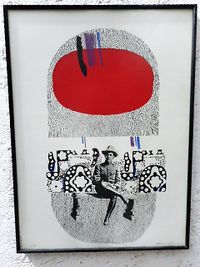
President Cárdenas and his administration are given credit by socialists for expanding the distribution of land to the peasants, establishing new welfare programs for the poor, and nationalizing the railroad and petroleum industries, including the oil company that Cárdenas founded, Petróleos Mexicanos. Toward the end of his presidency, unhappy landowners and foreign capitalists began to challenge his programs and his power. His choice of his close associate Manuel Ávila Camacho rather than a candidate with a distinguished record as a revolutionary leader was displeasing to many, and occasioned a possible military revolt.
The party that Cárdenas founded, the Partido de la Revolución Mexicana (PRM), established the basic structure of sectoral representation of important groups, a structure retained by its successor in 1946, the PRI. The PRI continued in power until 2000. This is attributed by some to electoral fraud and coercion. This legacy led his son, Cuauhtémoc Cárdenas, to form the Democratic Revolution Party (PRD) to contest the 1988 presidential election. Since that year, the PRD has become one of the three major parties in Mexico, gaining working class support that was previously enjoyed by the PRI.
انظر أيضاً
الهامش
- ^ Medin, Tzvi (1982). El minimato presidencial: historia política del maximato (1928-1935) (First ed.). México, D.F.: Ediciones Era. p. 144. ISBN 968-411-077-4. OCLC 8674374.
- ^ Barbosa Cano, Fabio Erazo (2020-03-12). "A 82 años de la expropiación petrolera en México". Instituto de Investigaciones Económicas. UNAM (in الإسبانية). Retrieved 2022-06-22.
- ^ Alan Knight, "Lázaro Cárdenas" in Encyclopedia of Latin American History and Culture, vol. 1, p. 555. New York: Charles Scribner's Sons 1996.
- ^ Batres Guadarrama, Marti. "Lázaro Cárdenas, el presidente del pueblo". La Jornada. Retrieved 12 September 2018.
- ^ Ayala, Rodrigo (19 May 2018). "Quién fue Lázaro Cárdenas y cuáles fueron sus aportaciones". Cultura Colectiva. Retrieved 12 September 2018.
- ^ Velazquez, Carlos. "Lázaro Cárdenas, el presidente más popular que ha tenido México". Sinaloa Dossier. Retrieved 12 September 2018.
- ^ أ ب The Course of Mexican History by Michael C. Meyer and William L. Sherman
- ^ Monday, Feb. 4, 1935 (February 4, 1935). "MEXICO: Ossy, Ossy, Boneheads". TIME. Retrieved October 15, 2011.
{{cite web}}: CS1 maint: multiple names: authors list (link) CS1 maint: numeric names: authors list (link) - ^ أ ب ت Tuck, Jim. "Mr. Clean: the phenomenon of Lázaro Cárdenas (1895–1970) : Mexico History". Mexconnect.com. Retrieved October 15, 2011.
- ^ "Mexico – Cardenismo and the Revolution Rekindled". Countrystudies.us. Retrieved October 15, 2011.
- ^ Alan Knight, "Cardenismo," p. 82.
- ^ Faces of the Revolution: "Lazaro Cardenas", The Storm That Swept Mexico: The Revolution, PBS
- ^ أ ب Knight, "Cardenismo," p. 82.
- ^ Allen Wells, "Reports of Its Demise Are Not Exaggerated: The Life and Times of Yucatecan Henequen," in From Silver to Cocaine: Latin American Commodity Chains and the Building of the World Economy, 1500-2000, Steven Topik, Carlos Marichal, and Zephyr Frank, eds. Durham: Duke University Press 2006, p. 315.
- ^ Knight, "Cardenismo," p. 95.
- ^ Javier Aguilar García, "Luis Napoleón Morones," in Encyclopedia of Mexico, vol. 2, p. 955. Chicago: Fitzroy and Dearborn 1997.
- ^ Smith 1996, p. 79
- ^ Dawson, Alexander S. Indian and Nation in Revolutionary Mexico, Tucson: University of Arizona Press 2004, pp. 74-78.
- ^ Dawson, Alexander A. “Moisés Sáenz”, in Encyclopedia of Mexico, vol. 2, pp. 1325–26. Chicago: Fitzroy and Dearborn 1997.
- ^ Howard F. Cline, The United States and Mexico, second edition. Cambridge: Harvard University Press 1961, p. 262.
- ^ Monday, Nov. 25, 1940 (November 25, 1940). "MEXICO: Cárdenas & Almazán Out". TIME. Retrieved October 15, 2011.
{{cite web}}: CS1 maint: multiple names: authors list (link) CS1 maint: numeric names: authors list (link) - ^ "Manuel Ávila Camacho – History.com Articles, Video, Pictures and Facts". History.com. Retrieved October 15, 2011.
- ^ Cline, United States and Mexico, p. 262.
- ^ Friedrich E. Schuler, "Francisco Múgica," in Encyclopedia of Mexico vol. 2, p. 975. Chicago: Fitzroy and Dearborn 1997.
- ^ Schuler, "Francisco Múgica," p. 975.
- ^ Cline, United States and Mexico, pp. 264-65.
- ^ Hamilton, Nora. "Lázaro Cárdenas" in Encyclopedia of Mexico, vol. 1, p. 194. Chicago: Fitzroy and Dearborn 1997.
- ^ أ ب Knight, "Lázaro Cárdenas" in Encyclopedia of Latin American History and Culture, vol. 1, p. 555.
- ^ Hamilton, "Lázaro Cárdenas", p. 194.
- ^ quoted in Krauze, Mexico: Biography of Power, p. 650.
- ^ Krauze, Mexico: Biography of Power,pp. 658-660
- ^ Preston, Julia and Sam Dillon, Opening Mexico: The Making of a Democracy. New York: Farrar, Straus and Giroux 2004, pp. 68-69
- ^ quoted in Preston and Dillon, Opening Mexico: The Making of a Democracy, p. 74.
المصادر
- Alan Riding, Distant Neighbors. نيويورك, نيويورك: Vintage Books - Random House, 1986.
- Becker, Marjorie. Setting the Virgin on Fire Lazaro Cardenas, Michoacan peasants, and the redemption of the Mexican Revolution. Berkelely: University of California P, 1995.
- La Cultura de Mexico, quoted in Manual Suarez Valles, Lazaro Cardenas: una vida fecunda al servicio de Mexico (Mexico City, 1971) p. 25.
1.The Political Legacy of Lázaro Cárdenas Author(s): Charles H. Weston, Jr. Source: The Americas, Vol. 39, No. 3 (Jan., 1983), pp. 383-405 Published by: Academy of American Franciscan History Stable URL: http://www.jstor.org/stable/981231 Accessed: 26/02/2009 14:16
2. Becker, Marjorie. Setting the Virgin on Fire Lazaro Cardenas, Michoacan peasants, and the redemption of the Mexican Revolution. Berkelely: University of California P, 1995.
| مناصب سياسية | ||
|---|---|---|
| سبقه أبلاردو رودريگز |
رئيس المكسيك 1 ديسمبر 1934 – 30 نوفمبر 1940 |
تبعه مانويل أڤيلا كماتشو |
| سبقه لويس مندز |
حاكم مچواكان 1928–1932 |
تبعه داماسو كاردناس |
| مناصب حزبية | ||
| سبقه إميليو پورتس |
رئيس الحزب الثوري المؤسساتي 1930–1931 |
تبعه مانويل پـِرز ترڤينو |
- CS1 الإسبانية-language sources (es)
- CS1 maint: numeric names: authors list
- Articles with hatnote templates targeting a nonexistent page
- رؤساء المكسيك
- زعماء الحزب الثوري المؤسساتي
- مرشحو الرئاسة المكسيكية (1934)
- حكام ميچواكان
- زعماء سياسيون في الحرب العالمية الثانية
- أعضاء الحزب الثوري المؤسساتي
- جنرالات مكسيكيون
- أشخاص من خيكيلپان
- حائزو جائزة ستالين للسلام
- مواليد 1895
- وفيات 1970
- وزراء داخلية المكسيك
- وفيات بالسرطان
